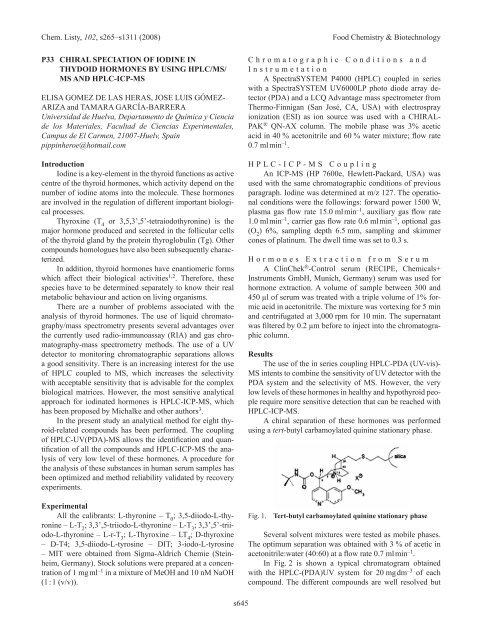3. FOOD ChEMISTRy & bIOTEChNOLOGy 3.1. Lectures
3. FOOD ChEMISTRy & bIOTEChNOLOGy 3.1. Lectures
3. FOOD ChEMISTRy & bIOTEChNOLOGy 3.1. Lectures
You also want an ePaper? Increase the reach of your titles
YUMPU automatically turns print PDFs into web optimized ePapers that Google loves.
Chem. Listy, 102, s265–s1311 (2008) Food Chemistry & Biotechnology<br />
P33 ChIRAL SPECIATION OF IODINE IN<br />
ThyDOID hORMONES by uSING hPLC/MS/<br />
MS AND hPLC-ICP-MS<br />
ELISA GOMEZ DE LAS HERAS, JOSE LUIS GóMEZ-<br />
ARIZA and TAMARA GARCíA-BARRERA<br />
Universidad de Huelva, Departamento de Química y Ciencia<br />
de los Materiales, Facultad de Ciencias Experimentales,<br />
Campus de El Carmen, 21007-Huelv, Spain<br />
pippinheroe@hotmail.com<br />
Introduction<br />
Iodine is a key-element in the thyroid functions as active<br />
centre of the thyroid hormones, which activity depend on the<br />
number of iodine atoms into the molecule. These hormones<br />
are involved in the regulation of different important biological<br />
processes.<br />
Thyroxine (T 4 or 3,5,3’,5’-tetraiodothyronine) is the<br />
major hormone produced and secreted in the follicular cells<br />
of the thyroid gland by the protein thyroglobulin (Tg). Other<br />
compounds homologues have also been subsequently characterized.<br />
In addition, thyroid hormones have enantiomeric forms<br />
which affect their biological activities 1,2 . Therefore, these<br />
species have to be determined separately to know their real<br />
metabolic behaviour and action on living organisms.<br />
There are a number of problems associated with the<br />
analysis of thyroid hormones. The use of liquid chromatography/mass<br />
spectrometry presents several advantages over<br />
the currently used radio-immunoassay (RIA) and gas chromatography-mass<br />
spectrometry methods. The use of a UV<br />
detector to monitoring chromatographic separations allows<br />
a good sensitivity. There is an increasing interest for the use<br />
of HPLC coupled to MS, which increases the selectivity<br />
with acceptable sensitivity that is advisable for the complex<br />
biological matrices. However, the most sensitive analytical<br />
approach for iodinated hormones is HPLC-ICP-MS, which<br />
has been proposed by Michalke and other authors 3 .<br />
In the present study an analytical method for eight thyroid-related<br />
compounds has been performed. The coupling<br />
of HPLC-UV(PDA)-MS allows the identification and quantification<br />
of all the compounds and HPLC-ICP-MS the analysis<br />
of very low level of these hormones. A procedure for<br />
the analysis of these substances in human serum samples has<br />
been optimized and method reliability validated by recovery<br />
experiments.<br />
Experimental<br />
All the calibrants: L-thyronine – T 0 ; 3,5-diiodo-L-thyronine<br />
– L-T 2 ; 3,3’,5-triiodo-L-thyronine – L-T 3 ; 3,3’,5’-triiodo-L-thyronine<br />
– L-r-T 3 ; L-Thyroxine – LT 4 ; D-thyroxine<br />
– D-T4; 3,5-diiodo-L-tyrosine – DIT; 3-iodo-L-tyrosine<br />
– MIT were obtained from Sigma-Aldrich Chemie (Steinheim,<br />
Germany). Stock solutions were prepared at a concentration<br />
of 1 mg ml –1 in a mixture of MeOH and 10 nM naOH<br />
(1 : 1 (v/v)).<br />
s645<br />
C h r o m a t o g r a p h i c C o n d i t i o n s a n d<br />
I n s t r u m e t a t i o n<br />
A SpectraSYSTEM P4000 (HPLC) coupled in series<br />
with a SpectraSYSTEM UV6000LP photo diode array detector<br />
(PDA) and a LCQ Advantage mass spectrometer from<br />
Thermo-Finnigan (San José, CA, USA) with electrospray<br />
ionization (ESI) as ion source was used with a CHIRAL-<br />
PAK ® Qn-AX column. The mobile phase was 3% acetic<br />
acid in 40 % acetonitrile and 60 % water mixture; flow rate<br />
0.7 ml min –1 .<br />
H P L C - I C P - M S C o u p l i n g<br />
An ICP-MS (HP 7600e, Hewlett-Packard, USA) was<br />
used with the same chromatographic conditions of previous<br />
paragraph. Iodine was determined at m/z 127. The operational<br />
conditions were the followings: forward power 1500 W,<br />
plasma gas flow rate 15.0 ml min –1 , auxiliary gas flow rate<br />
1.0 ml min –1 , carrier gas flow rate 0.6 ml min –1 , optional gas<br />
(O 2 ) 6%, sampling depth 6.5 mm, sampling and skimmer<br />
cones of platinum. The dwell time was set to 0.3 s.<br />
H o r m o n e s E x t r a c t i o n f r o m S e r u m<br />
A ClinChek ® -Control serum (RECIPE, Chemicals+<br />
Instruments GmbH, Munich, Germany) serum was used for<br />
hormone extraction. A volume of sample between 300 and<br />
450 µl of serum was treated with a triple volume of 1% formic<br />
acid in acetonitrile. The mixture was vortexing for 5 min<br />
and centrifugated at 3,000 rpm for 10 min. The supernatant<br />
was filtered by 0.2 µm before to inject into the chromatographic<br />
column.<br />
Results<br />
The use of the in series coupling HPLC-PDA (UV-vis)-<br />
MS intents to combine the sensitivity of UV detector with the<br />
PDA system and the selectivity of MS. However, the very<br />
low levels of these hormones in healthy and hypothyroid people<br />
require more sensitive detection that can be reached with<br />
HPLC-ICP-MS.<br />
A chiral separation of these hormones was performed<br />
using a tert-butyl carbamoylated quinine stationary phase.<br />
Fig. 1. Tert-butyl carbamoylated quinine stationary phase<br />
Several solvent mixtures were tested as mobile phases.<br />
The optimum separation was obtained with 3 % of acetic in<br />
acetonitrile:water (40:60) at a flow rate 0.7 ml min –1 .<br />
In Fig. 2 is shown a typical chromatogram obtained<br />
with the HPLC-(PDA)UV system for 20 mg dm –3 of each<br />
compound. The different compounds are well resolved but

















